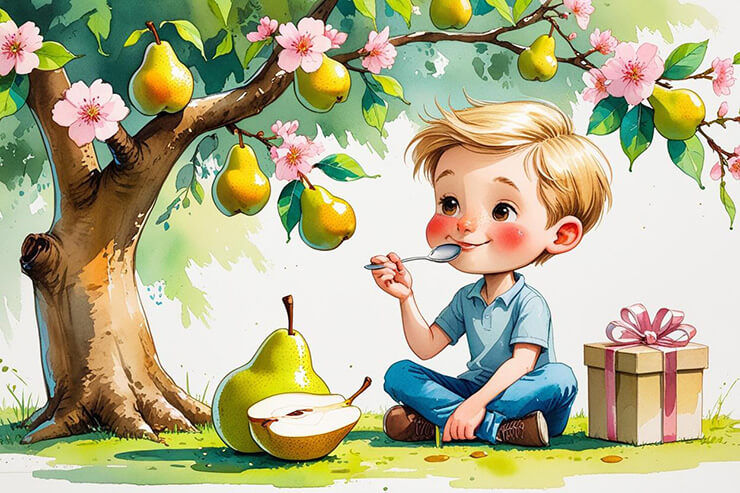Read by Michael Flamel

As a child, I never knew fruit could feel fancy—until my sister Patricia arrived on my birthday with a box that looked more like a royal treasure chest than a food gift. Nestled inside were 12 golden Royal Verano pears from Harry & David, each one gently wrapped in gold foil like nature’s own Fabergé eggs. Patricia instructed me to slice them in half and eat them with a spoon, as if they were tiny, personal desserts sent straight from heaven.
From the first bite, I was hooked. Silky, juicy, subtly floral—those pears were unlike anything else I’d tasted. I’ve since eaten my way through bushels of apples, bunches of bananas, and grapes by the gallon. But pears? Pears are what I treat myself to. Especially those velvety, spoonable varieties around the holidays. I still order them when I want to remember how a simple fruit can feel like a feast.
That childhood delight eventually led to a grown-up curiosity: could I grow my own?
From Fancy Gift to Backyard Grove: Pear Trees in America
Pears have been cultivated in North America since the 1600s, originally brought over by European settlers and now a favorite among backyard growers and orchardists alike. Unlike their sometimes-fussy cousin, the apple, pear trees tend to be more disease-resistant and once established, can produce delicious fruit for decades.
You’ll find pear orchards dotting the Pacific Northwest, especially Oregon and Washington, but home gardeners all across the U.S. have discovered the joy of growing their own pears. These trees aren’t just productive—they’re beautiful. With white blossoms in Spring and golden-leaved canopies in Fall, they add charm to any yard.
Choosing the Right Pear Tree (and When to Plant)
If you’re dreaming of pears dancing in your garden, here are a few tips:
- Pick the Right Variety for Your Zone:
- Bartlett: Juicy, classic, and great for USDA Zones 5–8.
- Bosc: Firm, spicy-sweet, and perfect for baking (Zones 4–8).
- Anjou: Smooth and mellow (Zones 5–9).
- Comice: Luscious and dessert-worthy—very close to those Harry & David treasures!
- Moonglow and Seckel: Excellent choices for cross-pollination and smaller spaces.
- Pollination is Key:
- Most pear trees need a pollination buddy! So, unless you’re growing a self-pollinating variety (like some Anjous), plan to plant at least two compatible types nearby.
- When to Plant:
- Late Winter to early Spring is ideal for planting bare-root trees.
- Container-grown trees can be planted anytime the soil is workable, but avoid extreme heat or frost.
How Many Trees Make an Orchard?
Technically, more than one tree is an “orchard.” But let’s be honest—once you have three or more, neighbors will start enviously whispering about your “mini orchard.” Own it.
Culinary Delights and Healthful Bites
Pears are a true culinary chameleon. Eat them raw, poached in wine, roasted with honey and rosemary, or folded into pies, crumbles, and chutneys. They’re also heavenly with cheese—especially gorgonzola or brie—and they make an elegant addition to salads and charcuterie boards.
Health-wise, pears are a sweet deal. They’re:
- High in fiber (especially if you eat the skin)
- A good source of vitamin C and potassium
- Hydrating and low in calories
And like bananas, they ripen off the tree, so you can pick them when firm and enjoy them at peak perfection a few days later.
Fun Pear Facts for Your Next Garden Party
- Pears are one of the few fruits that do not ripen on the tree. They’re picked green and allowed to ripen at room temperature.
- The phrase “pear-shaped” originated in British aviation slang. Don’t worry—your tree will only grow that way if you prune it badly!
- There are more than 3,000 known pear varieties in the world.
- Comice pears are nicknamed the “Christmas pear” because of their popularity in holiday gift boxes.
- A single mature pear tree can produce over 150 pounds of fruit in a season. Prepare your canning jars!
Ready to Plant Your Pear-fect Garden?
If you’ve ever been captivated by a spoonful of ripe pear or daydreamed about harvesting your own fruit, it might be time to plant a pear tree (or three).
Check out our Complete Gardening Guide on Pears—from choosing varieties and pruning like a pro to harvesting tips and truly amazing recipes your family will love. After all, the best time to plant a pear tree was 10 years ago. The second-best time? Right now—with a spoon in hand and visions of golden fruit to come. ❖


 Previous
Previous

